H 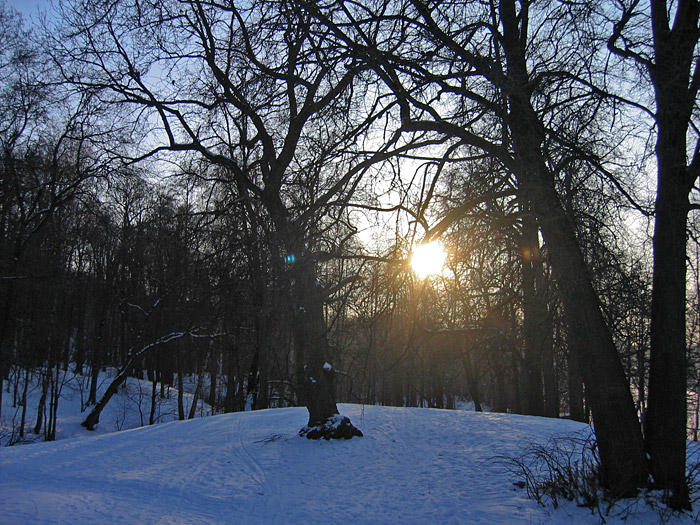 observation of events inanimate nature
observation of events inanimate nature

IN 
 When observing, first of all pay attention to the sun. What is it like today: dim, bright, covered with clouds? Remember what it was like yesterday. Mark the path of the sun in the morning, afternoon and evening according to landmarks.
When observing, first of all pay attention to the sun. What is it like today: dim, bright, covered with clouds? Remember what it was like yesterday. Mark the path of the sun in the morning, afternoon and evening according to landmarks.
Conclude that the sun rises later and sets earlier, so the days are getting shorter. In January, the day is noticeably longer, but it is getting colder. Say that the real winter is just beginning: frosts are ahead.
Ask the children what's going on with houseplants. Conclude that plants need light, and if the day lengthens, then there is more light. But why don't trees grow and turn green? What do plants need besides light? (They need warmth). Indoor plants grow in the warmth, and the trees outside are even colder than at the beginning of winter.
What joy the first snow brings to children! Rejoice with them. Let the children feel the fresh frosty air, smell the first snow.
Pay attention to the children how beautiful it is in winter. Winter, like an artist, paints everything around with a fluffy white brush. The trees no longer seem naked: they are dressed in a snow-white outfit; the paths also turned white.
Read the poem by I. Surikov "Winter":
White snow, fluffy,
Spinning in the air
And the earth is quiet
Falling, laying down.
And in the morning with snow
The field is white
Like a veil
All dressed him up.
P 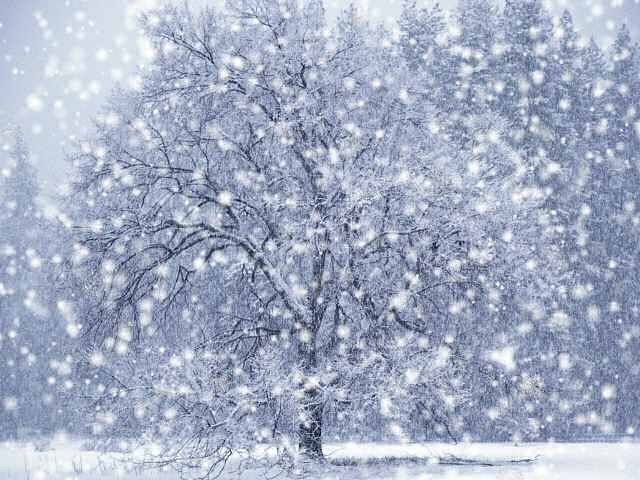 Offer to watch the snow spin and fall. Children love to collect it. When the snow flakes, point out to the children that it is easy to shovel it ... Look at the individual snowflakes. They are very beautiful in form: they look like stars, thin plates, flowers and needles. Most often, snowflakes have six rays.
Offer to watch the snow spin and fall. Children love to collect it. When the snow flakes, point out to the children that it is easy to shovel it ... Look at the individual snowflakes. They are very beautiful in form: they look like stars, thin plates, flowers and needles. Most often, snowflakes have six rays.
Pay attention to children that the shape of snowflakes changes depending on the weather: in severe frost, snowflakes fall in the form of solid large stars; in light frost, they resemble white hard balls, which are called cereals; in a strong wind, very small snowflakes fly (if you look at them through a magnifying glass, you can see that their rays are broken off); snowflakes are very beautiful when they swirl and shine in the evening by the light of a lantern.
If you walk through the snow in the cold, you can hear how it creaks. Tell the children that it is snowflakes that crunch and break underfoot.

No less beautiful sight when the snow falls in a continuous veil, behind which the contours of houses and trees are guessed. Teach your kids to enjoy the snow. Ask them why it's called that.
After a snowfall, there is a revival - the streets are cleared of snow everywhere. Watch the snow blower in action. Let the children think about how long it would take to shovel this snow by hand. And the snow blower works so fast that cars barely have time to drive up to it. Remember where the snow is taken.
Look at the snowdrifts on the street. Children will be interested in how deep they are. To do this, take a stick - a conventional measure (0.5 m) - and measure the depth of the snowdrifts in different places.
Offer to think about why the snow lies in a thicker layer near fences and bushes than in an open area. In these places it is not carried by the wind.
Admire the beauty of the tall snowdrifts, especially when lit by the bright January sun. Ask the children what to say about snow. They will answer that the snow is fluffy, deep, shaggy, layered, that it glitters in the sun, shimmers, sparkles.
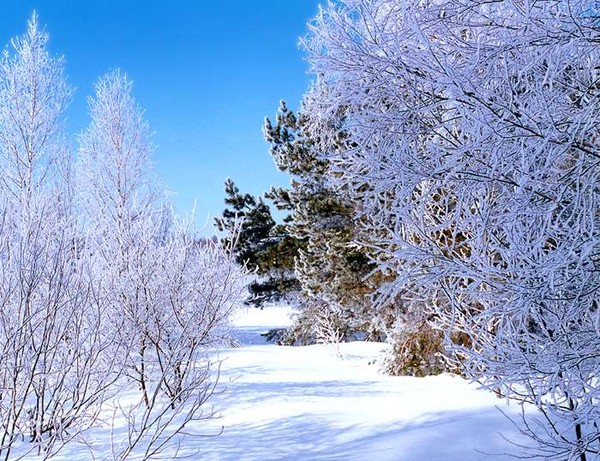

It is interesting in frosty weather to consider the patterns on the windows that sparkle in the sun with multi-colored lights. While observing, read the poem by I. Nikitin:
^
Burning frost crackling,
It's dark outside;
Silver frost
Launched the window.
On a walk, children build all kinds of snow buildings. On one of the walks, decorate the buildings with ice pieces, laying out or hanging them. Explain that ice and snow are water that has changed its appearance due to the cold. Make riddles:
Transparent as glass
Don't put it in a window.
(Ice.)
In the yard - a mountain,
And in the hut - water.
(Snow.)
^
E 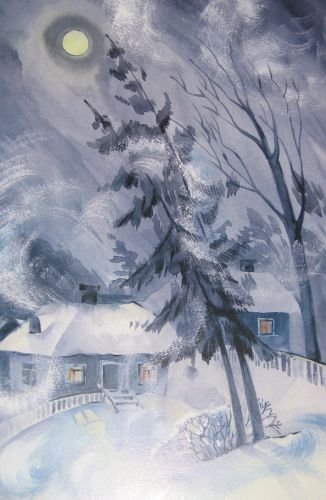 If frost strikes after a thaw, a
ice
. Explain this phenomenon. Offer to think about what needs to be done so that it is not slippery. Children offer to sprinkle the paths with sand. Pay attention to what wipers do in ice.
If frost strikes after a thaw, a
ice
. Explain this phenomenon. Offer to think about what needs to be done so that it is not slippery. Children offer to sprinkle the paths with sand. Pay attention to what wipers do in ice.
In February, you can observe blizzards, blizzards, and drifting snow. Have the children listen to the wind howling, see the clouds covering the sun and the snow blowing everywhere. Talk to them about how the forest dwellers feel now.
The next day, in a clear blue sky, the sun can shine brightly and even warm the tree trunks a little. Offer to touch the bark with your hand. Read an excerpt from A. S. Pushkin's poem "Winter Morning":
... Evening, do you remember, the blizzard was angry,
In the cloudy sky, a haze hovered;
The moon is like a pale spot
Turned yellow through the gloomy clouds.
And now ... look out the window:
Under blue skies
splendid carpets,
Shining in the sun, the snow lies ...
Watch with your children and such a phenomenon as a blowing snow. After that, they will easily remember the beginning of S. Marshak's poem "February":
^
The winds blow in February
Howling in the pipes loudly
Snake rushes along the ground
Light ground...
The sun rises higher and higher, but the heat is still far away. Finally, the children will see how drops drip from the icicles and the snowmen begin to “lose weight”.
The snow turns gray, settles, an ice crust appears at the top, which can be lifted: under it is loose white snow. While observing, read an excerpt from S. Marshak's fairy tale "Twelve Months":
The snow is no longer the same:
It darkened in the field.
Ice cracked on the lakes
It's like they split.
Clouds run faster
The sky got higher
Sparrow chirped
Have fun on the roof.
Plant observations

![]()
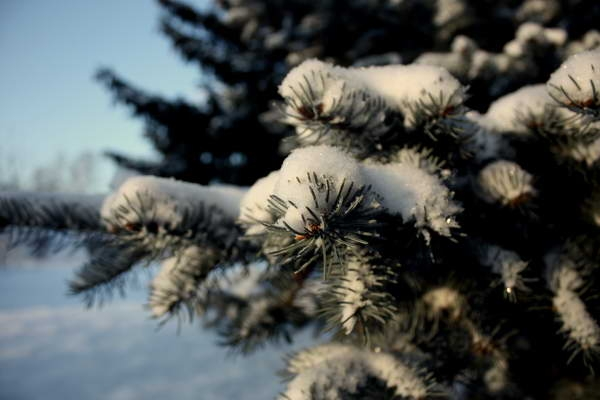
In winter, trees without leaves - you can clearly see their structure: crown, trunk, branch arrangement, compare with each other. Tell the children about the benefits of trees.
At the beginning of winter, the park is still elegant: in some places the mountain ash is red, and all the berries are intact on the elderberry. The snow slightly painted the trees, fluffed the spruces and pines. The park is spacious and quiet.
After admiring the winter view, invite the children to recognize the trees. Teach them to distinguish from shrubs. Trees have one thick trunk, while shrubs have many thin trunks.
Make a riddle:
^
Cheerful in the spring
It's cold in summer
Feeds in autumn
Warms in winter.
(Tree.)
Let the children try to explain each line of the riddle. Make another riddle: "In winter and summer in one color." Ask the names of trees such as pine and spruce. What coniferous trees do children still know? What is needles? What are the names of the trees whose leaves fall in winter?
Consider coniferous and deciduous trees, compare them with each other. Learn to distinguish trees and buds.
Spruce
.
The spruce trunk is straight, the bark is reddish-brown. The crown is like a cone. Branches with dense needles begin at the very ground. Kidneys are sharp, covered with scales. Narrow long cones hang on spruce. Tell the children that bears sleep in dens in dense spruce forests in winter, and hares hide under spruce branches.
Birch
.
Children will find it by its white trunk, thin twigs hanging down, and sometimes by preserved earrings. The tree stands powdered, on smoothly hanging branches, like lace, frost sparkles in the frosty sun. And it seems that the tree from the cold wrapped itself in a lace shawl and quietly
swinging in a frosty haze.
Larch
. The crown of the trees is rounded. The branches are long and short, the buds are with scales, the cones are round. Tell the children that larch is very common in the forests of our country. A branch with cones found on the ground and placed in a vase will decorate the room.
Poplar
. Tall tree with a slender trunk and a wide crown. The bark is yellow-gray with cracks. The branches are thick, of different lengths. Invite the children to touch and smell them; buds are sticky and fragrant. Say that poplar is a very useful tree: it cleans the air from urban smoke and dust.
Linden.
It can be distinguished from other trees by its dark, almost black trunk. The branches are directed to the sides and bend in the middle. "Like a bear swayed on them". Round buds are visible on the branches.
Many trees should not be taken for comparison. Let the children know the signs of three or four well, be able to recognize them, tell about them.
^
Consider shrubs too.
Lilac
. All children know fragrant lilac flowers. Its leaves remain green until frost. The kidneys are large. Say that lilac is easy to take root and grows quickly.
To consolidate knowledge about trees and shrubs, play the game "Learn by description". An adult describes some tree or shrub, and
The game "Guess how many steps." Invite the children to guess how many steps from the bench to the linden, from the linden to the maple .... First you need to determine by eye, and then check. This game develops orientation in space, an eye and helps to fix the names of trees.
Play the Scouts game by giving the children the following tasks: find the tallest or lowest tree; find and bring a larch branch with cones; find footprints and determine who they belong to, etc.
Teach your children to take care of trees. Show how branches are bent after a snowfall. Shake the snow off them carefully. Bring one branch and put in the water. After a while, bend it - it does not break, it only bends, which means that the tree is alive.

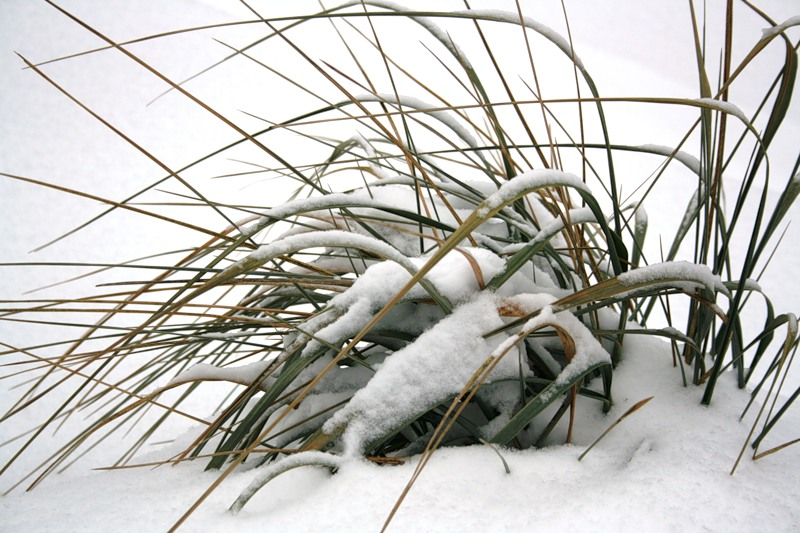
Show how grasses hibernate. Dig up the snow and the children will see green grass in the depths. So she's not cold under the snow. Explain that plants need rest, so indoor plants are watered less often in winter.
Animal observations
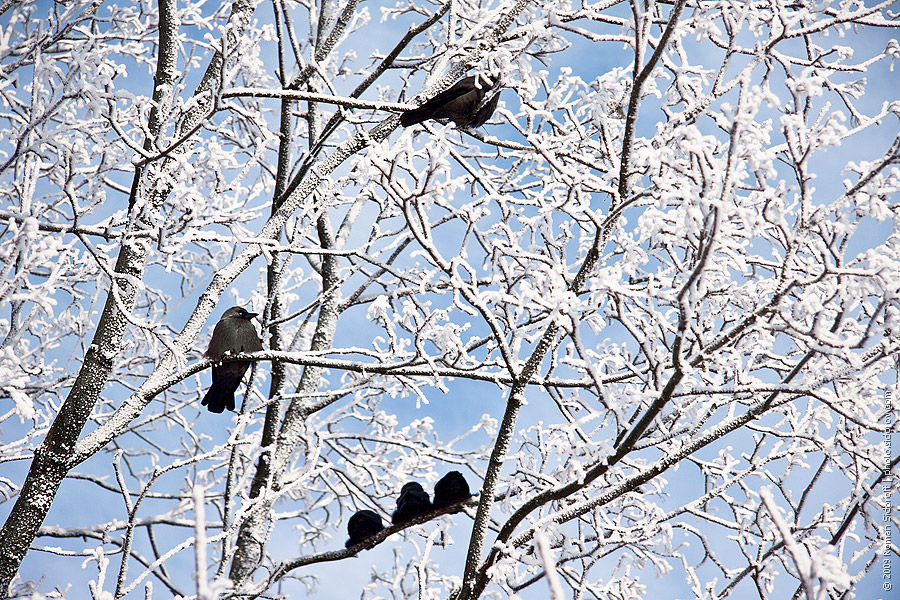

Watching the birds at the feeder, the children notice that with the onset of cold weather, more of them began to arrive .... Appeared sedate, calm bullfinches. Offer to listen to their melodic quiet whistling. “They ring like bells,” the children say. Bullfinches come to life only when they need to fly somewhere. They call to each other and fly away. Bullfinches love berries.
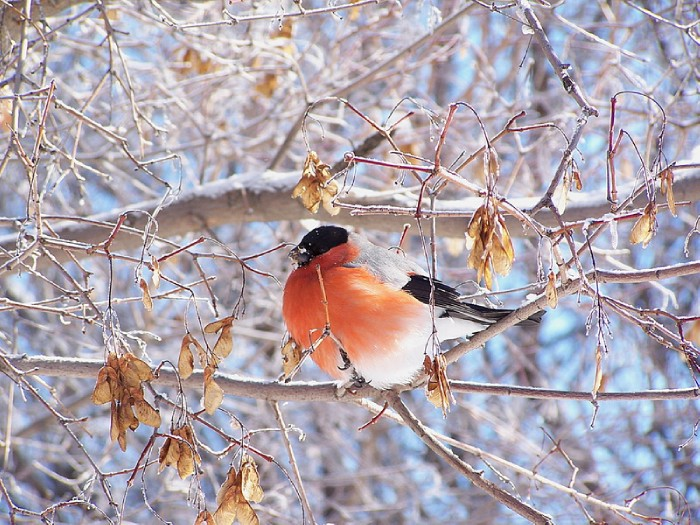
^ Read the poem by L. Tatyanicheva
"Bullfinches":
Shrubs blushed
Not from the dawn.
These are red lanterns.
The snowmen lit up.
Pay attention to the behavior of birds in different weather. In frost, they sit ruffled, chirp less, and in thaw they are lively, they fly more.
Appeared and goldfinches.
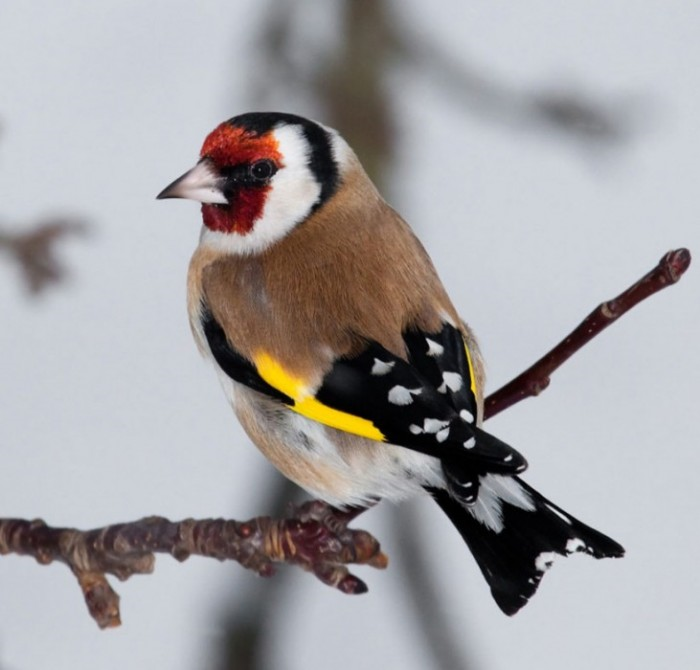
Gradually, their flocks increase. They are very beautiful: bright yellow stripes on black wings, a red spot on the forehead. Goldfinches are very mobile.
Children really like to watch their noisy guests, feed them. They are all so different. Especially a lot at the feeder sparrows. They are always with us.
P 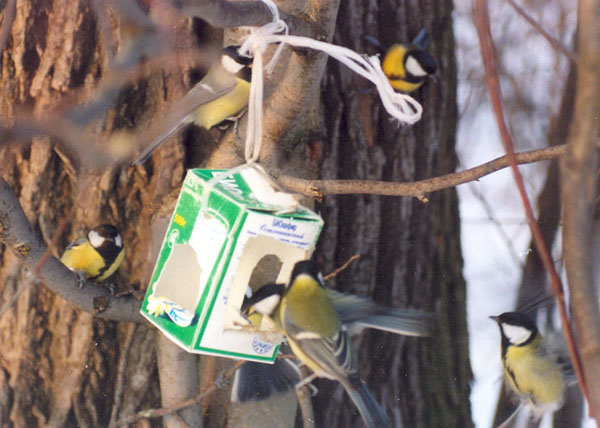
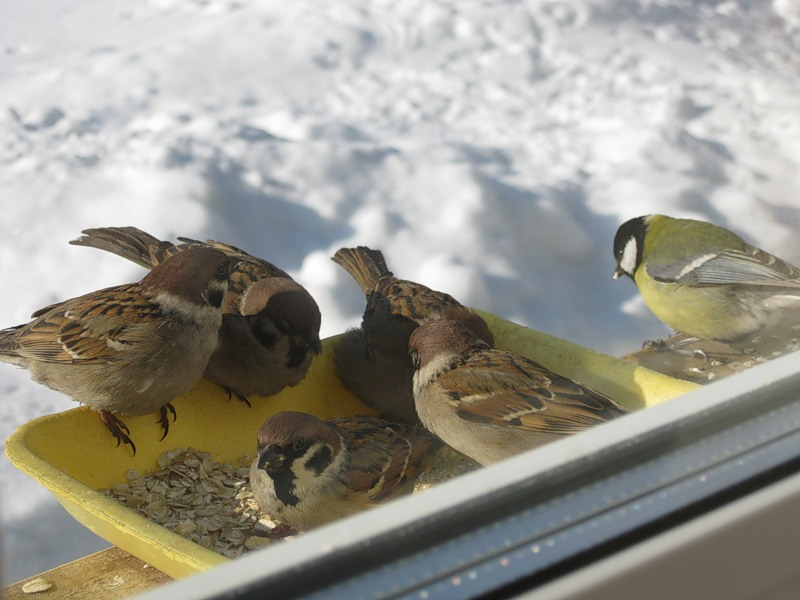 recite a poem about them:
recite a poem about them:
The bird's nests are empty
The birds flew south.
Turned out to be the bravest
Our yard sparrow.
Kholodov was not afraid
Stayed with us for the winter.
Snow covers the whole earth -
Sparrow do not lose heart:
A flock merrily scurries,
Everything that meets, peck.
Don't feel sorry for the bread crumbs:
The sparrow deserved them.
You put a feeder on him -
He calls his girlfriend
And friends are all right there,
The little ones peck merrily.
And a cheerful knock went -
Knock-Knock,
Knock-Knock,
Knock-Knock,

Wild and domestic animals .
Tell us how animals live in the forest in winter.
Read the poem by I. Tokmakova:
Like on a hill - snow, snow,
And under the hill - snow, snow,
And on the tree - snow, snow,
And under the tree - snow, snow,
A bear sleeps under the snow.
Hush hush. Keep quiet!
Bear
sleeps restlessly: no, no, yes, and looks with a green eye from a hole in the lair, then turns on the other side and sleeps again. And in the middle of winter, the she-bear has cubs - tiny cubs. They are warm around their mother. And the hedgehog is sleeping, it was also covered with snow.
A fox and wolf
running around in search of food. The fox is not cold, she seems to have put on felt boots: there is thick wool on her legs. The fox smells mice that run under the snow along the snowy corridors. She sniffs the air for a long time, then starts jumping in the snow, and the mice, frightened, run out.
Bunny
sits under a bush all day. The snow is white, and the hare is white - you can't even see him. And at night he will jump obliquely to look for food: he will gnaw the bark of the trees, he especially loves aspen. If young fruit trees are not covered and tied with spruce branches, he may peel them too.
Elk
foresters prepare hay and branches for the winter.
Talk to your children about pets, tell them about their habits.
All animals love affection and caress themselves to humans.
Cat tries to sit closer to the radiator: she loves warmth. Sometimes a cat scratches wooden objects: she needs to sharpen her claws. If you let the cat out - take a walk in the yard, she will recognize her house and will definitely return. The cat is very clean: after eating, she carefully washes herself and is careful - she knows how to deftly hide from her enemies.
Dogs
attached to the owner: they like to walk with him, guard the apartment.
01/25/2012 prepared by the educator preparatory group No. 1 Gorchakov. S.Yu.
Materials of the book by M. V. Lucic "For children about nature" were used
1. Seasonal and weather phenomena.1. Seasonal and weather phenomena.
The sun is shining brightly. Rains are rare, warm, sometimes torrential, with lightning, thunder and hail. In
the time of observing the rain of children leads to an understanding of the causes different nature precipitation
in winter and summer, their dependence on air temperature. Interesting to watch the morning and
evening dew, fog, explain the reason for their formation. It's cold at the beginning of summer
the weather changes frequently. From mid-June it gets hot. Show and clarify: fine
day, summer rain. Associate seasonal conditions with lightweight children's clothing. Listening
poems contributes to a colorful perception and brings children to the concept - summer
red. Show a bright seasonal phenomenon - a rainbow. Older children study in separate
signs to determine the state of the weather. Midsummer comes in July, from the time of flowering
lindens. July is the hottest month of the year, with frequent showers and thunderstorms. Warm water in the pond
you can swim. Summer ends in August. The days are warm, but the sun no longer bakes so
strongly, as in July. Thunderstorms end, cool winds and fogs appear. Water in
reservoirs are cooling down. To show children that summer has the longest day,
continue to observe the time of sunrise and sunset, which are carried out in different
seasons. On walks, they observe the height of the sun. In the preparatory group
determining the height of the sun, you can observe the shadow from objects, from the children themselves in the morning, when
the sun has not yet risen high, and in the afternoon, when the sun is almost overhead, measure the length of the shadow. For
observations, it is necessary to choose an open convenient place, stick a stick into the ground and observe
the shadow cast by a vertically standing stick illuminated by the sun. The children notice
that the higher the sun rises, the shorter the shadow of the stick. Based on familiarity with folk
With signs, children learn to notice changes in nature, to predict weather conditions.
2. Water, sand, clay, pebbles, shells.
Given to children under the supervision of an adult. Ideas about the properties of these natural materials
refined, deepened and consolidated in the process of organized observations and
children's independent activities. The most relevant and favorite games in the summer
are games with water and sand.
Wildlife observations in summer 1. Plant observations in summer
Walking with children in the park, pay attention to the trees in the square. in the trees andshrubs - lush and green foliage. Children examine the leaves of various trees,
note that they are different in shape, size; distinguish and name bushes and trees. Meadow
flowers: dandelion, St. John's wort, yarrow, clover, chamomile, tansy, bluebell. Garden:
peony, phlox, gladiolus, nasturtium, rose, aster, dahlia. People prepare hay, collect
harvest of vegetables, fruits and berries. Observations are carried out in order to enrich ideas
children about plants. The ability to pay attention to the beauty of nature, the ability to see
beautiful, admire it. Children learn to take care of plants, not to crush, not to tear them unnecessarily.
2. Animal watching in summer
Continue to work on familiarization with animals. Pin views received
children in the spring. Animals take care of the cubs, teach them to get food, hide from
enemies. Children should know how animals behave, how they call their mom and dad. Junior
imitate the movements and voice reactions of animals, the elders list. Pupils
it should be explained where homeless animals come from, why they are dangerous.
3. Bird watching in summer
In summer, children continue to watch birds. Pay attention to how fast they flybirds, catching insects, note how often they fly to the nest with food for
chicks. The teacher tells that the birds feed their chicks in the summer
insects, thus helping to preserve plants. Exploring the trees, the children will meet
with traces of the destructive work of bark beetles and woodcutters. The kids will do it themselves.
conclusion: "If there are no birds, then the forest will die." We must warn preschoolers that nests
birds must not be touched, otherwise they will cease to live in them. In July, the teacher draws
children's attention to how the birdsong gradually subsides.
4. Observation of insects
Many insects appear: a butterfly, a grasshopper, a bee, an ant, a fly, a beetle, a mosquito, a dragonfly.
Butterfly, moth, admire them all together, examine the structure of their bodies with the help of
magnifiers. Invite the children to listen to the chirping of a grasshopper, watch how it jumps and
hiding in the grass. Arouse in children a good attitude towards this harmless creature. God's
cow, beetle. When observing, use a magnifying glass. Consider cobweb legs, a crack
on the back, wings. To form a desire to admire and protect living beings, not
harm them. In summer, children and adults are annoyed by unpleasant "neighbors" - flies,
wasps. However, in nature there is nothing superfluous. Explain to the children that flies destroy
rotting plant and animal remains, being orderlies. Wasps are beneficial
eating harmful insects, including houseflies. Needs to be developed in children
careful attitude to insects.
Galina Mamontova
Perspective plans for observing animate and inanimate nature in the senior group
Senior group
Observations of inanimate nature
SEPTEMBER
No. Subject observation Purpose
1 Week Observation behind the dew - where it settles, what it looks like, admire the shiny droplets.
Learn observe natural phenomena, analyze
2 weeks Observation behind the sun - where was the sun in the morning, where is it now? When was it warmer? When the sun is shining brighter: morning or afternoon? Develop memory, the ability to compare.
3 week Observation behind the shadow - why is it obtained? Pay attention to the fact that in the morning and evening the shadow is long, and in the afternoon - Develop interest in the environment, desire observe.
4 week Observation for the general state of the weather - the sun does not shine so brightly, dew appears, the days become cooler, remember the concept of "early autumn". Develop interest in the environment, desire observe.
No. Subject observation Purpose
1 Week Observation behind the fog - when the fog was thicker: morning or afternoon? What does it look like, what does it consist of? Introduce autumn phenomena, be able to draw conclusions about patterns nature.
Week 2 Pay attention to the illumination during the day, to the duration days: the days have become shorter, the nights are longer To consolidate the concept of seasonal phenomena, the ability to analyze the results observations.
3 week Observation behind the rain - what is the sky like during the rain, does summer rain differ from autumn rain and how? Did the outside temperature change during the rain? Learn to build sentences based on your own observations.
4 week Observation behind the sky - do clouds appear in parts, what kind of sky? How bright is the sun? "In October, say goodbye to the sun, move closer to the stove." To fix the signs of autumn, to introduce the signs of October, to clarify the concept of "golden autumn".
No. Subject observation Purpose
1 Week Observation behind frost - what lies on the grass, objects; what does frost look like? How do you explain the words "freeze"? Develop observation the ability to think.
2 weeks Observation behind the wind - from which direction does the wind blow? Determine the strength of the wind, what can be said about it? (cold, strong, frosty) Learn to choose the right words.
Week 3 Offer to measure the air temperature - is it warmer than in the morning? Where is the temperature higher in the shade or in the sun? Can we say that the sun is hot? Why? Develop desire observe learn to draw conclusions and explain them.
4 week Observation for the state of the weather - note that the illumination of the day has changed, the air temperature has become low, a cold wind is blowing. To form the concept of autumn, to clarify the concept of "late autumn". "November - the gates of winter."
No. Subject observation Purpose
1 Week Observation behind the falling snow pay attention to the flight snowflakes - easy, smoothly fall separately snowflakes or flakes. Learn observe natural phenomena, see its beauty, analyze the results observations.
Week 2 Examining ice in puddles - what determines the thickness of the ice? Can you walk on ice? What is ice? To form elementary ideas about the transition of a substance from their liquid state to a solid state.
3 week Observation behind the sun - is the sun hot, does it stand high? What color sun: bright yellow or pale? Develop skill observe, talk about their observations.
4 week Observation for seasonal changes - what month does December follow? What time of year does November belong to? How has the general appearance of the site changed compared to autumn? Why are tree roots covered with snow? How do people dress in winter and autumn? Form ideas about changes in nature at the beginning of winter(the night is growing and the day is waning); introduce the proverb "December closes the year, winter begins".
No. Subject observation Purpose
1 Week Observation behind frosty patterns on windows: there are flowers and leaves on the glass - everything sparkles, everything is white, but without paints and without a brush the glass is painted. A wonderful artist visited the window, guess, guys, who painted the window? (freezing) In what weather do patterns form? Why are they formed? How does frost draw them? To teach to see the beautiful, to distinguish the characteristic signs of winter, to recognize them in literary texts, poems.
2 weeks Ice watch: what is ice? How does it appear? What is dangerous? Continue to form elementary ideas about the transition of a substance from a liquid to a solid state.
3 week snow watching: what is snow? Where is it formed snowflakes? What does snow feel like? Why does snow creak? When is snow wet, when is dry? What kind of snow is easier to sculpt? Why?
To form an idea of the properties of snow; offer to consider snowflakes through a magnifying glass to learn to notice the beauty of the environment nature.
4 week Sky watching: what color is the sky low or high? What is the sky covered with? How did the children determine that these were clouds? -
Develop skill observe draw conclusions and explain them,
introduce the sign of January "January - Midwinter".
5 week Watching footprints in the snow: who passed here (adult or child) Whose footprint is this (bird, animals, traces of the car and skis) The footprint is fresh or old? How did you determine? -
Develop observation, thinking, the ability to justify your answer, interest in the environment.
No. Subject observation Purpose
1 Week Observation behind the sun - is the sun hot, is it high? What color is sun: bright yellow or pale? -.
develop skill observe, activate vocabulary, build sentences correctly
2 weeks Watching the wind: how do we determine if there is wind? What is the strength of the wind? And if it snows and the wind blows, what can these phenomena be called? (drifting snow, blizzard, blizzard, snowstorm)
expand children's ideas about winter phenomena.
3 week Review icicles: why didn't they drip in the morning? When they drip, why? Why do they form? Does the icicle grow or shrink on a frosty day? And in sunny? What is the difference between a place where there are icicles and another area? Why do icicles grow "head down"? (As the droplet flows down the icicle, it pulls out the tip and it becomes thin.)
develop the ability to analyze results observations and draw conclusions about patterns nature.
4 week Observation behind the melting snow - where does the snow melt faster? Why? What does melted snow become, what does it turn into?
To form an idea of the transition of a substance from a solid to a liquid state.
No. Subject observation Purpose
1 Week Sun watching: it began to appear more often in the sky, has it become warmer? Is the day getting shorter or longer? How will you prove it?
develop observation the ability to draw logical conclusions.
2 weeks Observation behind the rain - what can you say about it (strong, shallow, drizzling, downpour). What's it like when it's raining? (wet, damp, dull Develop skill observe, select definitions.
Week 3 Examining stones - suggest find: the most beautiful, the most brilliant, unusual, smooth, rough. Develop an interest in the environment. Ability to describe your definitions.
4 week Observation to describe the weather is it true that spring has already come? How did you feel it, see it?
Develop observation, clarify knowledge of signs early spring, introduce the saying "March meets spring, fights winter."
No. Subject observation Purpose
Week 1 Considering sand and earth - how did the sand become (dry, warm, loose, and what was it like in winter? What did the earth become (dry, dark, appeared on it) Develop a desire observe, compare.
2 weeks Observation for an increase in daylight hours - has the day increased? Why? Does the sun rise earlier or later? To develop children's concept of seasonal changes.
3 week Observation behind the sky - pay attention to the blueness of the sky, to the fact that it has become higher. What do clouds in the sky look like? Develop imagination ability to see what is happening in the nature of the change.
4 week Observation behind the fog - what are you watched in the morning, did the fog clear during the day? What does it consist of, what does it resemble? Why is fog dangerous? To develop the desire to share impressions, to think. Introduce proverb: "April - colors the earth."
No. Subject observation Purpose
1 Week Observation for air temperature - offer to measure the air temperature during a walk - has it become higher or lower than in the morning? Where temperatures are higher in the shade or in the sun, why? Develop thinking, desire observe.
2 weeks Watching the first thunderstorm. What is a thunderstorm? - it is rain, and wind, and lightning at the same time. Can you walk during a thunderstorm? What it threatens To acquaint children with spring phenomena.
3 week Observation behind the air - is there air around us? How to detect it, offer to wave your hand in front of you - what do you feel? Develop interest.
4 week Observation for the state of the weather - determine and characterize the state of the weather, introduce the proverb "Rain in May - three" Activate the children's dictionary, fix the signs of late spring.
Senior group
Wildlife Observations
SEPTEMBER
No. Subject observation Purpose
1 week Comparison of the Colorado potato beetle with " ladybug"Note the characteristic features of the external structure, color; the main vital functions: breathe, move, grow, multiply, cultivate a humane attitude towards everything alive.
2 weeks grasshopper watching.
To consolidate the concept of the originality of this living being, features of its structure, lifestyle.
3 week Examination of the spider and the web. Give an idea of the environment.
Insect Watching.
To give an idea of the relationship and interaction of living organisms in ecosystems. Give an idea of the composition of meadow communities, environmental conditions,
No. Subject observation Purpose
1 Week Observation for a dog Expand children's understanding of domestic animals to show feelings animal: hunger, joy, affection.
2 weeks Observation behind the cat Expand the idea of the manifestation of feelings animal: pleasure, joy, affection, affection.
3 week Watching a horse
foal. To give a concrete idea that all living beings grow, develop, reproduce, the characteristic features of the structure of data animals.
4 week Observation behind the cow Expand the idea of domestic animals, give an idea of the system of needs animal: optimum temperature, habitat, food, about their general dependence
No. Subject observation Purpose
1 week Conversation "The Red Book - what is it?" Explain environmental dependencies, the awareness of which contributes to the development of modern environmental awareness in children.
2 weeks Observation for migratory birds, preparation for departure. Expand children's knowledge of seasonal changes in basic environmental conditions a habitat: days became shorter, less light, cold rains, winds, there was nothing to eat, birds
3 week bird watching.
Comparative
characteristic. Expand understanding of the composition of the community, the habitat birds: forest, field, garden, give ideas about establishing links with the conditions of their existence.
Week 4 Making a feeder Expand knowledge that a person treats the environment with care and humane a habitat: protects the birds, makes food troughs so that the birds don't die in the winter.
No. Subject observation Purpose
1 Week Observation behind the tit using fiction. Continue to arouse interest in birds; expand children's ideas about the titmouse, its habits, habitat.
2 weeks Crow watching, introduce omen: a crow hides its nose under its wing - to frost Expand the idea of \u200b\u200bwintering birds, learn to distinguish them by appearance; educate love and respect for wintering birds.
3 week pigeon watching. Consolidate ideas about the bird world (what birds eat, where they live, how a person cares for them).
4 week Observation for a tit and a sparrow in comparison, using an artistic word. Deepen knowledge about the life of birds in winter period; develop the ability and desire to help them.
No. Subject observation Purpose
1 week Looking at the rabbits in the picture.
Expand your understanding of care animals, about the conditions of labor processes for care.
2 weeks cat watching. Expand children's understanding of the world animals, educate the desire to take care of them.
3 week dog watching.
Develop thinking, the ability to protect yourself, the desire to help as far as possible.
4 week Observation for the fish in the aquarium.
To give children an idea of what is among the fish
predators, activate the dictionary.
week Examining paintings with the image animals of hot countries: camel, elephant, giraffe. Improve knowledge of life animals, develop observation the ability to talk about their observations.
No. Subject observation Purpose
1 Week Watching pets in winter.
Consolidate knowledge about life at home animals in winter time of the year; form an idea of what is at home animals are taken care of by a person(prepares food, prepares food, cleans the house).
2 weeks Observation for wintering birds using the artistic word. To consolidate knowledge about wintering birds; to form an idea of obtaining food by wintering birds; to instill a desire to take care of them and protect them.
3 week Spider watching.
Give an idea of originality and uniqueness living being about his life properties: breathing, movement, nutrition.
4 week Observation for winter birds.
Clarify children's knowledge of birds, develop interest in nature.
No. Subject observation Purpose
1 Week Observation for chickens with chickens Expand the idea of poultry, about caring for them, about meeting their needs.
2 weeks Observation for the first migratory birds Expand the understanding of seasonal change and the return of migratory birds in connection with this.
3 week Observation for wintering birds Learn to notice and note changes in the behavior of birds due to seasonal changes.
4 weeks animals: bear, squirrel, hedgehog, wolf, fox, elk. Be able to notice that with a change in habitat conditions, changes occur in the life and behavior of wild animals, expand the idea of helping human wild animals.
No. Subject observation Purpose
1 Week Ant watching. To expand the understanding of the features of the structure, the relationship between the habitat of creatures and the features of their structure.
2 weeks Observation"Bees are collective insects". Expand knowledge of the needs of this species in terms of environments: light, air, food, habitat, protection from enemies.
3 week Observation for geese with geese. To expand knowledge about poultry, about human care for birds.
4 week Pet watching(consideration) Learn to notice changes in their lives due to seasonal changes; expand knowledge about living conditions at home animals.
No. Subject observation Purpose
1 Week Watching animals near the pond. Expand knowledge about life properties animals: food, breathing, movement, drinking.
2 weeks Observation of animals of the meadow natural environment of the zone. Learn to notice changes in their lives due to seasonal changes.
3 week Conversation "Red Book" Introduce children to its main purpose: identification and accounting of those species of organisms that may disappear, and for the conservation of which special protection measures are needed.
4 week Observation for varieties of butterflies. Develop the ability to distinguish the originality and originality of each living being, the need for careful and caring attitude to nature.
Senior group
plant observations
SEPTEMBER
No. Subject observation Purpose
1 week (poplar, willow, lilac, wolfberry). Concretize children's ideas about the main plant groups, to consolidate the ability to distinguish them by bark, fruits, seeds. Show aesthetic experiences in the process of communication with nature.
2 week Examination autumn colors V bouquet: asters, roses, dahlias. To fix the name of the flowers of early autumn, to expand the idea of \u200b\u200bplants in the garden, ideas about work, a person growing garden flowers.
3 week Observation behind the grass in the meadow with by reading:
"You grass, my grass.
You, grass, my silk.
But who trampled you, the grass?
They trampled me, grass,
Yes, all kids, yes, all small
Walking in the green garden
Running playfully. Expand children's understanding of herbaceous meadow plants.
Week 4 Review vegetables: carrots, cabbage, tomatoes, cucumbers. To consolidate the idea of vegetables, to consolidate knowledge of the basic labor processes for caring for garden plants.
No. Subject observation Purpose
1 Week Observation: "Golden autumn"with reading "Summer Flies" by Trutneva. To consolidate the idea of seasonal changes, the main conditions of the main conditions of the habitat; to consolidate the concept that plants have adapted to changes, shed their leaves, trees and shrubs.
2 week Consideration of autumn colors: chrysanthemums, oaks. Develop the ability to give comparative characteristic mid-autumn flowers; consider the idea of garden plants.
3 week Observation behind grassy plants: plantain, sorrel. Expand your understanding of plants meadows: plants have adapted to the autumn changes, shed their seeds, begin to wither.
(illustrations). Variety- news: edible, inedible by reading: "For mushrooms". To consolidate knowledge about edible and poisonous mushrooms; to expand the idea of the environmental conditions to which the mushrooms have adapted - a certain temperature, light, humidity.
No. Subject observation Purpose
1 Week Watching thuja and cherry. To consolidate the ability to give a comparative description of the bark, fruits; expand the idea of major changes in one species in comparison with other species.
2 weeks Observation for the distribution of burdock seeds. To expand the knowledge of children about the propagation of plants by seeds.
3 week Review houseplant- aloe. To consolidate the knowledge that plants are medicinal, including aloe. Reinforce the concept that
Plants get nutrition from the soil with the help of roots, propagate by cuttings.
4 week Quiz "vegetables and fruits" with riddles. D / I "Find out by description." To consolidate the ability to classify objects according to essential features.
No. Subject observation Purpose
1 Week Observation for the growth and development of violets and ficus.
To form the idea that some plants grow quickly and bloom, while others grow slowly. To consolidate the idea that plants breathe in all parts, reproduce by petioles, leaves.
2 weeks Elm watching. To form ideas about the winter ash, about how you can help him survive the cold winter.
Week 3 Examination of models of fruits - apple, pear, plum, orange, lemon - introduce the concept "citrus"
To give an idea that their cultivation requires certain conditions: humidity, temperature, illumination.
4 week Observation behind the trees in the hoarfrost Admire the crystal beauty created nature. pay attention to the state nature around kindergarten and the need to protect it. Cultivate intolerance to senseless damage to plants
No. Subject observation Purpose
1 week Continued observations behind the growth of violets and ficus.
To teach to see changes in plant growth, to clarify the idea of \u200b\u200bplant growth, which is necessary for their growth.
2 weeks Observation for potato sprouts.
Develop an interest in plant life, the ability to determine what they need for better growth.
3 week Observation for cherries in winter To form knowledge about the features of the life of trees in winter; to cultivate a caring attitude towards plants (do not touch branches and buds that are fragile from frost, as they break).
4 week Observation behind the flowering Decembris. To develop interest in plants, the ability to notice changes, to fix the rules for caring for them.
a week Watching thuja and elm: What do these trees have in common? What is the difference?
Strengthen the ability to give a comparative description; expand the idea of major changes of one species in comparison with other species.
No. Subject observation Purpose
1 Week Observation for the kidneys on the lilac.
Expand children's ideas about plant life, continue to teach to take care of plants.
2 weeks Tree and shrub observation- compare two types of plants.
Exercise in the ability to give a comparative description, develop observation.
3 week Observation for sprouted beans.
To consolidate the idea of \u200b\u200bthe growth, development and reproduction of plants.
4 week Observation behind the branches blooming in a vase.
to consolidate children's knowledge about the necessary conditions for the growth and development of plants, to develop interest in the environment.
No. Subject observation Purpose
1 Week Observation of trees and shrubs. Comparison of buds on branches, in a vase and on trees. Summarize the idea of characteristics spring - swelling of the kidneys, develop the ability to compare objects nature
Week 2 Examination of blooming Tradescantia Generalize the idea of the characteristic signs of spring - swelling of the buds, develop the ability to compare objects nature on the basis of differences and similarities.
3 week Consideration of the first spring colors: daffodils, blueberries, snowdrops, tulips with Serov's "Snowdrop" reading. Admire the flowers, give a concrete idea of the dependence of growth, development and reproduction; about the condition of the most pleasant environment for this time of year.
Week 4 Entertaining quiz "Where is the vegetable, where is the fruit?" Expand knowledge about vegetables and fruits, know their characteristics, be able to classify
No. Subject observation Purpose
1 week Examination of indoor plants - balsam and geranium Clarify children's understanding of the function of plants, cultivate the desire to create favorable conditions for plant life.
2 weeks Observation for flowering trees and bushes. Continue to develop an understanding of seasonal changes Learn to communicate adverse events coherently nature, explain them, consolidate the ability to compose a story about observable.
3 week Observation for a variety of herbaceous plants: dandelion, violet with reading verse - I "Dandelion" Vysotskaya. To expand the understanding of the composition of meadow communities, to consolidate the understanding of the environmental conditions to which grasses are adapted.
Week 4 Examining mushrooms (album) with riddles about mushrooms To consolidate the knowledge of children about edible and poisonous mushrooms, ideas about the adaptability of mushrooms to a certain heme-re, humidity, light that are in the forest.
No. Subject observation Purpose
1 week Continued observation behind the grassy cover with the reading of the poem "It's good in the spring." Continue to concretize the ideas that children have about the diversity of the plant world.
Week 2 D/I "Know the tree". To consolidate the ability to classify objects according to their essential featured: the ability to compare by flowers, leaves, color, smell.
Week 3 Examination of a houseplant - grapes and garden grapes. To give a generalized idea of plant life in a normal ecological system and indoors.
Week 4 Conversation "The wealth that surrounds us." Reinforce children's understanding of flora, about its continuous movement, change and development.
Observation of objects of animate and inanimate nature and maintenance of the "Calendar of Nature" and "Diary of Observations"
Disclosure of the main semantic concepts formed by younger students
Calendar:
method, method of counting days in a year;
a table or book with a list of all days of the year;
from the Latin "calenda" (the name of the first day of the month among the ancient Romans);
time system based on periodic natural phenomena - the change of seasons.
Phenology- a science that studies the relationship of climatic factors with periodic (seasonal) processes occurring in the life of plants and animals.
folk omen- a distinctive property, a sign that is followed, watched.
Seasons periods in which certain natural phenomena occur.
Season one of the four seasons.
Natural phenomena- manifestation of something in nature.
Keeping a "Weather Calendar" and "Calendar of Nature"
In the 2nd grade, students continue to make systematic observations of the weather phenomena of nature, maintain a “Weather Calendar” or “Nature Calendar” at the choice of the teacher. The latter involves observing not only weather phenomena (the state of the sky, precipitation, wind, air temperature), but also the changes that occur in wildlife in accordance with the seasons.
Approximate content
The "Calendar of Nature" helps us to observe certain natural phenomena and see their sequence and dependence on each other. The folk calendar has existed for many hundreds of years, our ancestors used it, and we will use it too. It is based on numerous observations of the peculiarities of the course of natural phenomena that were once recorded. Initially, we observe and check the validity folk signs related to the weather, because they are built on specific material that is easy to observe in the city, see the results and make you water. The peculiarity of folk signs about the weather is that they give a short-term forecast (for example, what the weather will be like in the evening or the next day).
We observe and check signs by season.
Spring:“Long icicles - for a long winter”, “Clouds float high - for good weather”, “The sun sets red - for the wind”, “Blue clouds - for heat and rain”, “Cold - the oak leaf unfolds”.
In summer:“Dandelion squeezes the ball for rain”, “In the morning the grass is dry - expect rain by night”, “In the anthill, the passages are open and the movement of insects is noticeably brisk - to good weather”, “Earthworms crawl out - to bad weather”, “God's the cow, taken on hand, quickly flies off - to sunny weather.
Autumn:“Sparrows fly in flocks from place to place - before a strong wind”, “Long afternoon rain”, “Frosty hoarfrost on the grass - to rain”, “Clouds go low - expect a cold”, “Clouds ran into one pile - be rain."
Winter:“A crow hides its beak under its wing - to the cold”, “The wind blew from the north side - to great cold”, “Thunder - to strong winds”, “The stars shine strongly - to frost”, “If there was frost at night, snow will not fall during the day ”, “Three days before the full moon - a change in the weather.”
A teacher or parents from a huge number of folk signs related to weather forecasting should choose a few and acquaint the second grader with their content in advance, working ahead of the curve. It is necessary to print them, together with the child to pick up pictorial material illustrating them, and observe the weather every day. The most important condition the formation of motivation for observational activity is sensory perception as the basis for cognition of activities that are led by adults. Observation is important to combine with conversations, games, reading fiction.
If we keep the “Calendar of Nature” with children, then in this case we use predictions - we determine the course of opposite or successive seasons. For example: “A lot of acorns on an oak - to a frosty winter”, “If a lot of cobwebs fly in the spring, the summer will turn out to be hot”, “In the summer the leaves turn yellow on the trees - by early autumn”, “In autumn, birds fly low - to a cold winter, high - to warm", "Damp summer and warm autumn - to a long winter", " Cold winter- Hot Summer".
It is also interesting to observe phenological phenomena of nature and compare their dates with the present ones.
At the same time, you should know that phenologists divide the year into seasons and subseasons. There are 4 seasons, and 14 subseasons, characteristic periods limited by boundary phenomena of wildlife. Thus, spring in the European part of Russia is divided into 4 periods: snowmelt (spring of light), revival of spring (spring of big water), the height of spring (green spring ) and foreshadowing.
Interesting information about the seasons and their course can be found in A. Strizhev's book "Calendar of Russian Nature".
Spiritual and moral development and education of junior schoolchildren. Guidelines. Part 2./ Ed. A. Ya. Danilyuk - M .: "Enlightenment" - p.-81-83
Visual Arts Program for Primary School "Nature and the Artist"
ProgramProgram for fine arts For elementary school created on the basis of the requirements for the results of mastering the basic educational programs of primary general education(second generation standards, 2009).
Work program on the federal state educational standard of the second generation for grade 1 at the level of primary general education
Working programmMain educational program educational institution MOU Konevskaya secondary school was developed in accordance with the requirements of the Federal State educational standard primary general education, approved by order
Programs "Researchers of Nature" for general educational institutions of institutions of additional education
ProgramPrograms "Researchers of nature" are the result of many years of work of associations of ecological and biological profile of the Republican Ecological Center for Children and Youth.
Explanatory note. 3 Brief description of the used umk. 8 2
Explanatory noteThe main educational program of primary general education of the Municipal General Educational Autonomous Institution "Secondary Comprehensive school No. 8
The main educational program of primary general education of the municipal educational institution (3)
Main educational programThe main educational program of primary general education (PLO) for schools working on the textbooks of the Harmony system has been developed in accordance with the requirements of the Federal State Educational Standard for Primary
The multifaceted world arouses interest in preschoolers and is surprising. “Sincere amazement at the revealed secret of nature is a powerful impetus for a rapid flow of thoughts,” notes V.A. Sukhomlinsky.
One of the main methods of introducing children to nature is observation.
Observation - this is a purposeful, systematic, more or less long-term perception of objects and phenomena of the surrounding world by a person. It is associated with the display of changing phenomena. Its purpose is not only to acquaint children with objects or phenomena, but also to teach them to notice changes in the environment. Children observe the behavior and habits of animals, changes in the life of plants, in inanimate nature.
The teacher helps children master the activity of observation, sets them a cognitive task, teaches in a different way inspection of objects, teaches to follow the proposed observation plan, and then independent planning, forms the ability to select characteristic essential features in accordance with the tasks set.
Observations can be short-term (observation of the weather, the behavior of birds, fish, animals) and long-term (observation of the development of plants, seasonal phenomena, objects of inanimate nature).
In the studies of many scientists, the need to specifically teach preschoolers to observe nature is emphasized.
Depending on the object and the age of the children, observations can be episodic, lasting several minutes (short-term) and long-term, which are conducted for many days, and sometimes weeks.
Long-term continuous observations are especially important.
To accumulate knowledge about the growth and development of plants and animals, seasonal changes in nature, observations of inanimate objects, long-term observations are used. At the same time, children compare the observed state of the object with what it was before. Long-term observations are valuable in that they allow children to capture the sequence in the onset of natural phenomena, establish cause-and-effect relationships.
These observations are children younger age performed under the guidance of the educator, and the senior preschool age- on one's own.
The educator directs the observation, he explains to the children the goals of observation, asks questions that direct their attention to an object or phenomenon. A valuable methodological technique that activates the thinking of children during observation is comparison, comparison characteristic features objects or phenomena by difference and similarity. When comparing objects of nature, children easily establish signs of difference.
The upbringing of a caring attitude towards nature is possible when children have at least elementary knowledge about it, master simple ways of growing plants, caring for animals, learn to observe nature, to see its beauty.
Children of primary preschool age are very interested in observing water. The proposed system of continuous observations of water with children of primary preschool age contributes to the development of observation, curiosity, the development of logical and figurative thinking, cognitive activity, develops and improves speech activity and analytical skills. In addition, it generates interest in experimental activities.
System of continuous observations of natural objects
within a month with children of primary preschool age
1. Observation conversation “Everyone needs water.”
Target: To form children's ideas about the qualities of water necessary for the growth, life of all plants, animals and humans. Bring to the understanding that fish, birds, animals and humans cannot live without water. Develop the ability to establish cause-and-effect relationships. To give children emotional satisfaction from communicating with each other and playing with water.
2. "Introduction to the properties of water (experiments with water)".
Target: To form children's knowledge about the qualities of water - transparent, clean, has no taste; about the properties of water - liquid - flows; sinking-not sinking (using various items).
3. "Where does the rain come from?" (observation of clouds and clouds).
Target: To give children the idea that clouds are made up of tiny water droplets that gather into large droplets - clouds and then it rains. Develop the ability to establish cause-and-effect relationships.
4. “What kind of rain happens” (observation of the rain).
Target: To form in children an idea of different types rain (small, large). To increase the level of environmental knowledge, cognitive and speech activity of children. Consolidation of the dictionary - rain from a cloud.
5. "Heavy rain - big puddle"(observation on walks of puddles formed after rain).
Target: To form an idea of \u200b\u200bchildren about the properties of rain: heavy rain - a large puddle, light rain - a small puddle. The rain watered the beds - observation of the soil after the rain.
6. Conducting the outdoor game "Sun and Rain" on a walk.
Target: To develop the ability of children to establish causal relationships: the sun is walking, the rain is hiding under an umbrella, we are running away.
7. Experimenting on a walk. Experience "Sand-Water".
Target: Develop causal relationships: water - pours, it is liquid; sand - pours, it is free-flowing. Develop the ability to conduct elementary experiments with water and sand. To form an idea of \u200b\u200bchildren about the properties of sand (dry - pours, wet - you can sculpt).
Bibliography:
1. V.N. Volchkova, N.V. Stepanov "Summaries of classes: cognitive development, speech development, ecology." 2008.
2.S.N. Nikolaev. Familiarization of preschoolers with inanimate nature - Pedagogical Society of Russia, Moscow 2005.
3.N.A. Ryzhov. I and nature: Proc. -method. environmental education kit for preschoolers. - M.: LINKA-PRESS, 1996, p. 56, (Ser. "Nature is our home").
4. N.A. Ryzhov "Water Sorceress".
5. Experimental activities of children of middle and senior preschool age: Toolkit. - St. Petersburg: CHILDHOOD-PRESS, 2011. - 128 p.
6. Unexplored nearby: Experiments and experiments for preschoolers / Ed. O. V. Dybina. - 2nd ed., M .: TC Sphere, 2011. - 192 p.
